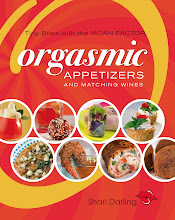
If you're interested in hosting a unique New Year's Eve, consider an elegant, but simple wine and cheese tasting. I'm talking about your hosting an event that is not 'cliche' or predicatable, like pairing red wine and Ermite blue cheese.
Consider pairing one style of cheese, such as Cheddar and its various strengths with different wines. Keep it simple.
When you pair one cheese with several wines you experience a deeper personal connection with your own senses -- your sense of smell, taste and feel. Said another way, you begin to notice more about our own sense of taste than focusing on the cheese and wine.
Pairing one style of cheese of different strengths with several wines also allows you to experience how different strengths of the same cheese create wonderful taste and flavour reactions in and around various parts of your mouth.
I hosted this kind of event a while back. I choose Jensen Cheese because this company specializes in different strengths of Cheddar and Cheddar related cheeses. It's trendy to celebrate the local angle, too.
I hosted this kind of event a while back. I choose Jensen Cheese because this company specializes in different strengths of Cheddar and Cheddar related cheeses. It's trendy to celebrate the local angle, too.
Jensen produces fabulous Cheddars. The company has a long history of cheese making in Ontario, opening in Simcoe in 1925 by master Denmark cheesemaker, Arne Jensen. Since its inception, Jensen has won many awards for their products.
The goal of our tasting was to determine if any specific guidelines exist that can be applied to wine and cheese.
The first discovered guideline is this: You can successfully pair wines and cheeses of the same weight, even if their strengths differ. My guests and I found that different strengths of Cheddar -- mild, medium or extra strong -- can all harmonzie with high alcohol reds. They just harmonize in a variety of ways.
What do I mean by equal weight? (Fattiness is mouth feel, also known as texture. Cheddar is high in fat. Austere reds, such as Grenache, Cabernet Sauvignon or Malbec are generally high in alcohol (14% to 15%). High alcohol gives wine more viscosity (thickness). This thickness is experience on the palate as 'fatty.' So the fattiness in all Cheddars (despite mild, medium, strong and extra strong) match the weight and fattiness of high alcohol reds.
The second guideline is that strong Cheddars can soften the bitterness (tannin) in austere red wines.
We sampled ten cheeses and seven austere red wines. Of this group, two pairings stood out. The Pari Estate Pangkarra Grenache 2005 (CSPC 127335), $18.95, from Australia is a delicious red with classic ripe blackberry fruit and licorice flavours, full body and a long, enjoyable finish. When paired with Jensen’s old Cheddar, the combination was pleasant with the cheese’s flavour softening some of the wine’s bitterness (tannin.) If this wine is not available at your local LCBO, choose any Australian Grenache with forward fruit character.
The third guideline reveals that a strong red wine partnered with mild Cheddar (but of equal weight) allows the wine to shine.
When we paired an Australian Grenache with Jensen’s Marble cheese the combination reacted differently. In this partnership, the cheese allowed the wine's full character to dominate.
This specific guideline is important if you're planning on wowing your New Year's Eve guests with a fabulous vintage you've been cellaring for a while. Choose a Cheddar with equal weight, but of softer flavour.
We also enjoyed a Duval-Leroy La Fleur Leroy 2004 (CSPC 17228), $19.15, from France. It offers lots of earthy, barnyard flavours on the nose with a palate that is medium bodied, earthy and spicy.
We also enjoyed a Duval-Leroy La Fleur Leroy 2004 (CSPC 17228), $19.15, from France. It offers lots of earthy, barnyard flavours on the nose with a palate that is medium bodied, earthy and spicy.
This red with an extra old cheddar created perfect harmony on the palate.
The fourth guideline then? Strong reds obviously work with extra old Cheddars.
Yet, when paired with Monterey Jack, the wine provided up front flavours; the cheese providing intensity of flavour on the back palate.
If this wine is unavailable, choose a 2007 Ontario Cabernet Sauvignon to partner to an old Cheddar and Monterey Jack.
If you decide to undertake this wine and cheese tasting at home this New Year's Eve, contact Jensen Cheese at 1-866-625-0615 or go to http://www.jensencheese.ca/, to find out where the products are available in your neighbourhood. An LCBO wine consultant can help you choose a variety of fruit forward and austere red wines.
If you decide to undertake this wine and cheese tasting at home this New Year's Eve, contact Jensen Cheese at 1-866-625-0615 or go to http://www.jensencheese.ca/, to find out where the products are available in your neighbourhood. An LCBO wine consultant can help you choose a variety of fruit forward and austere red wines.









































